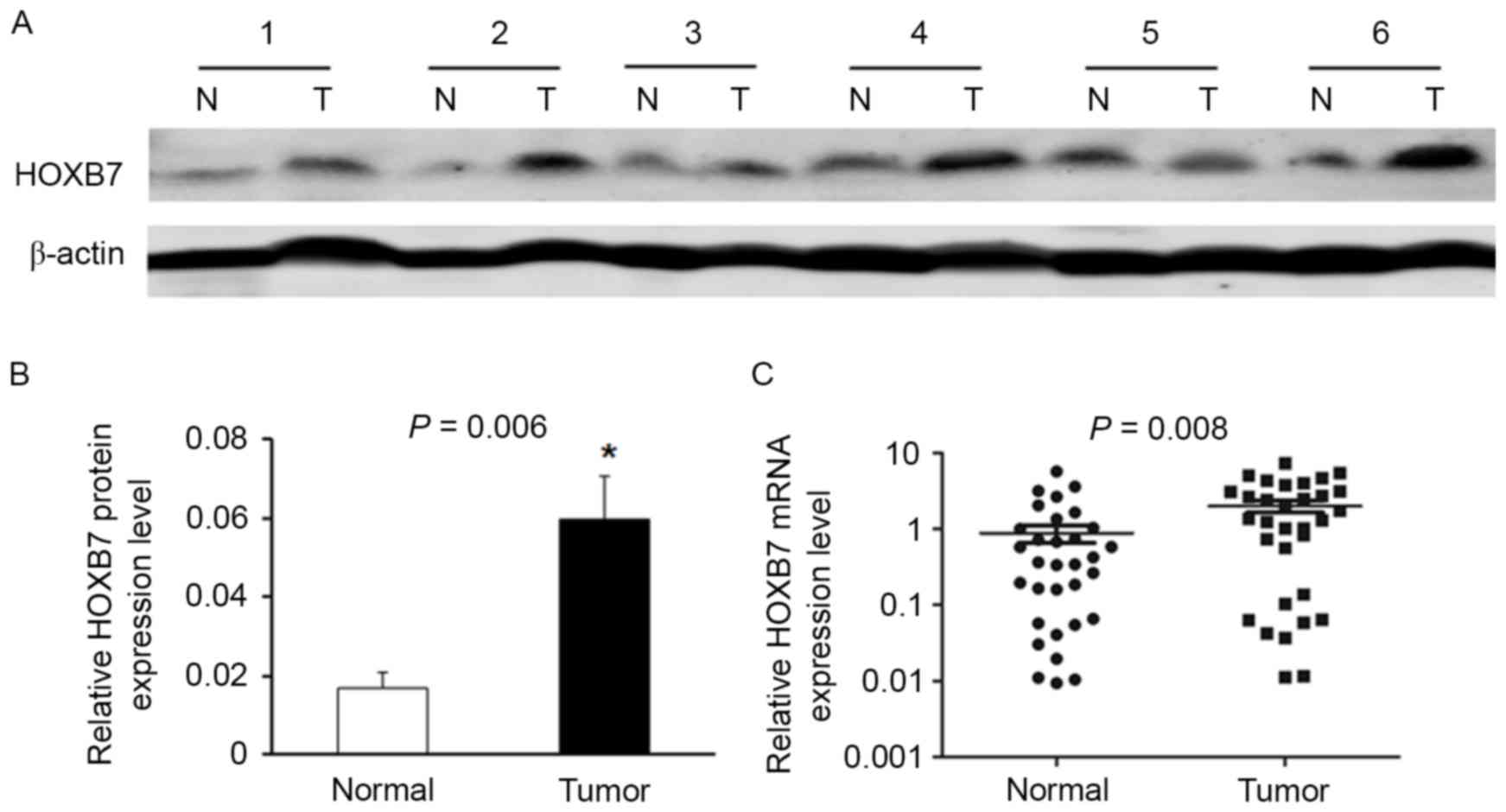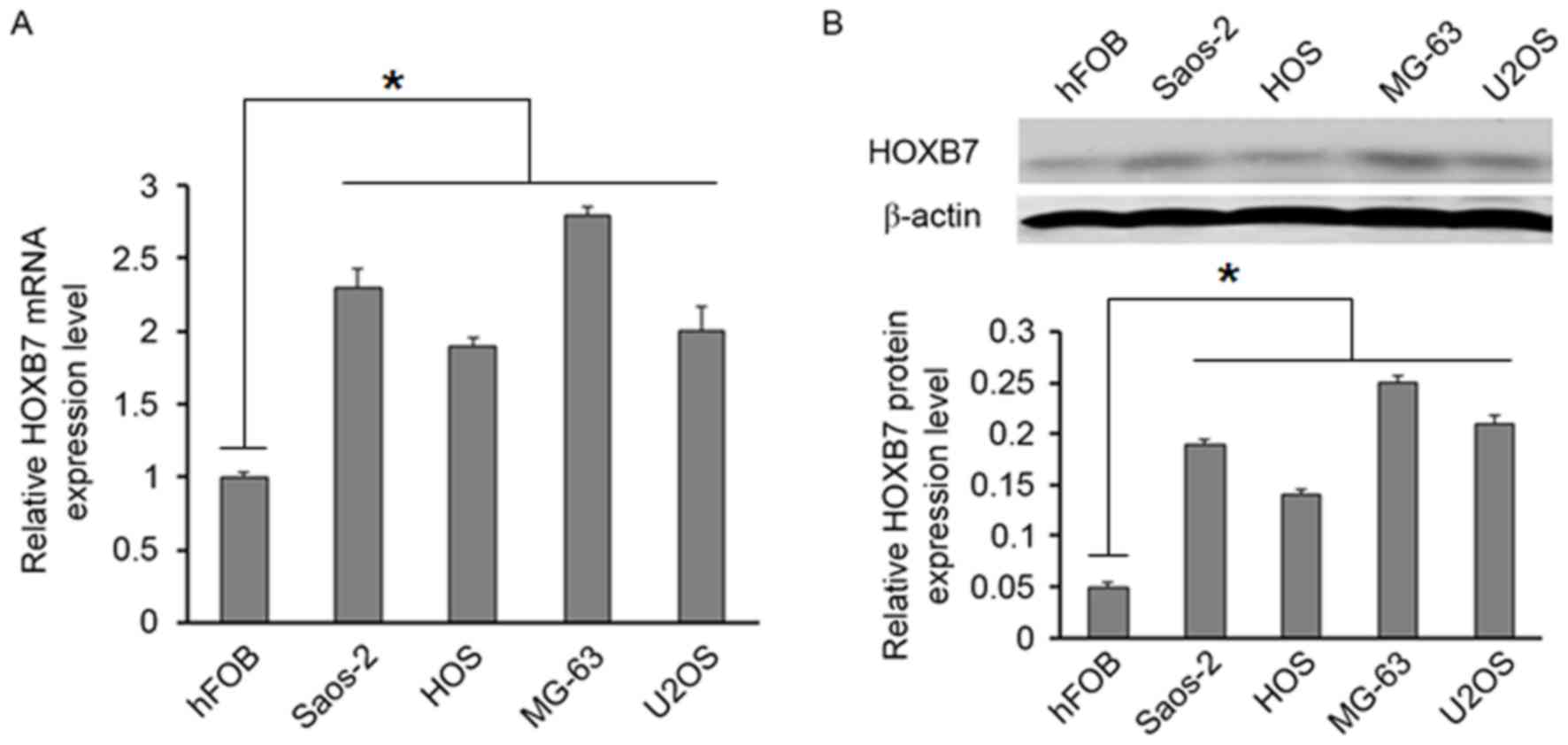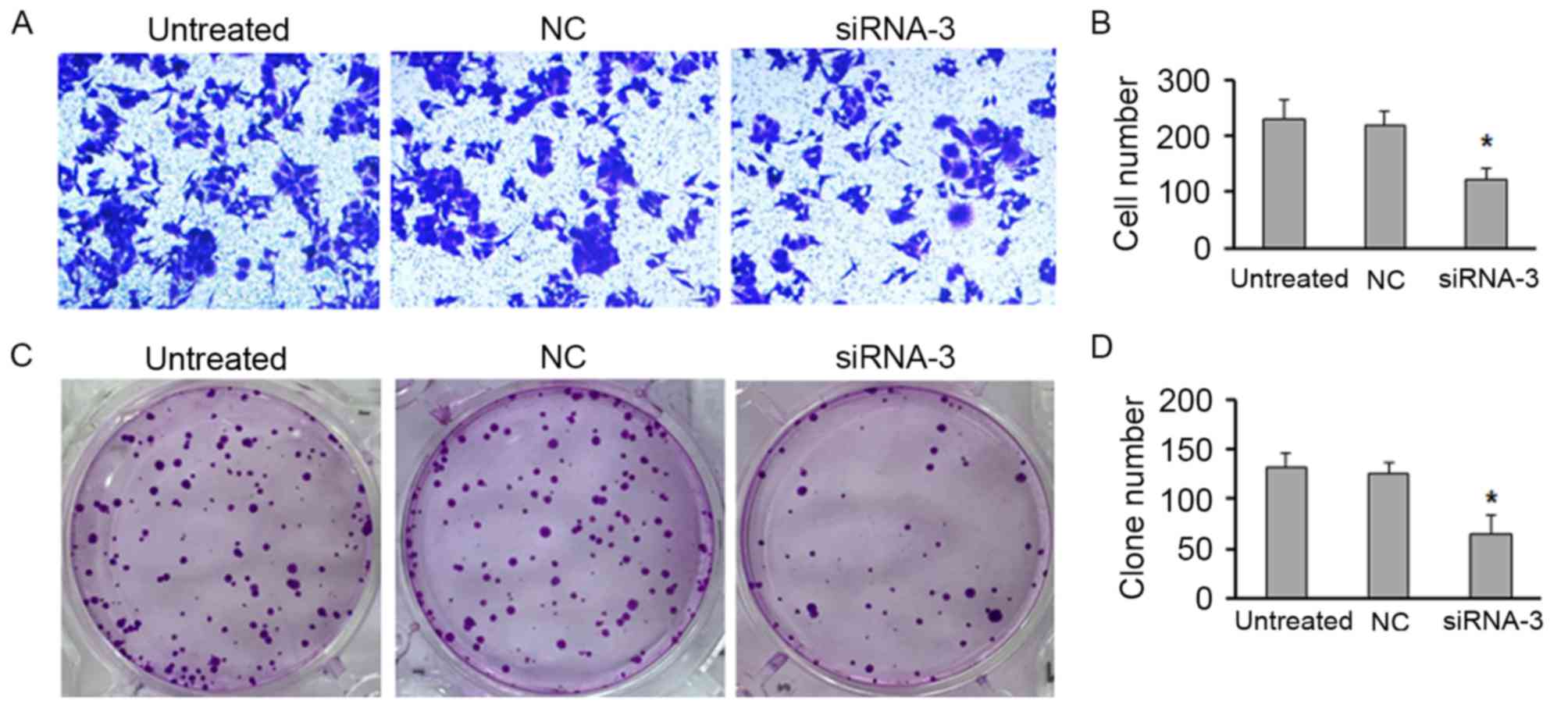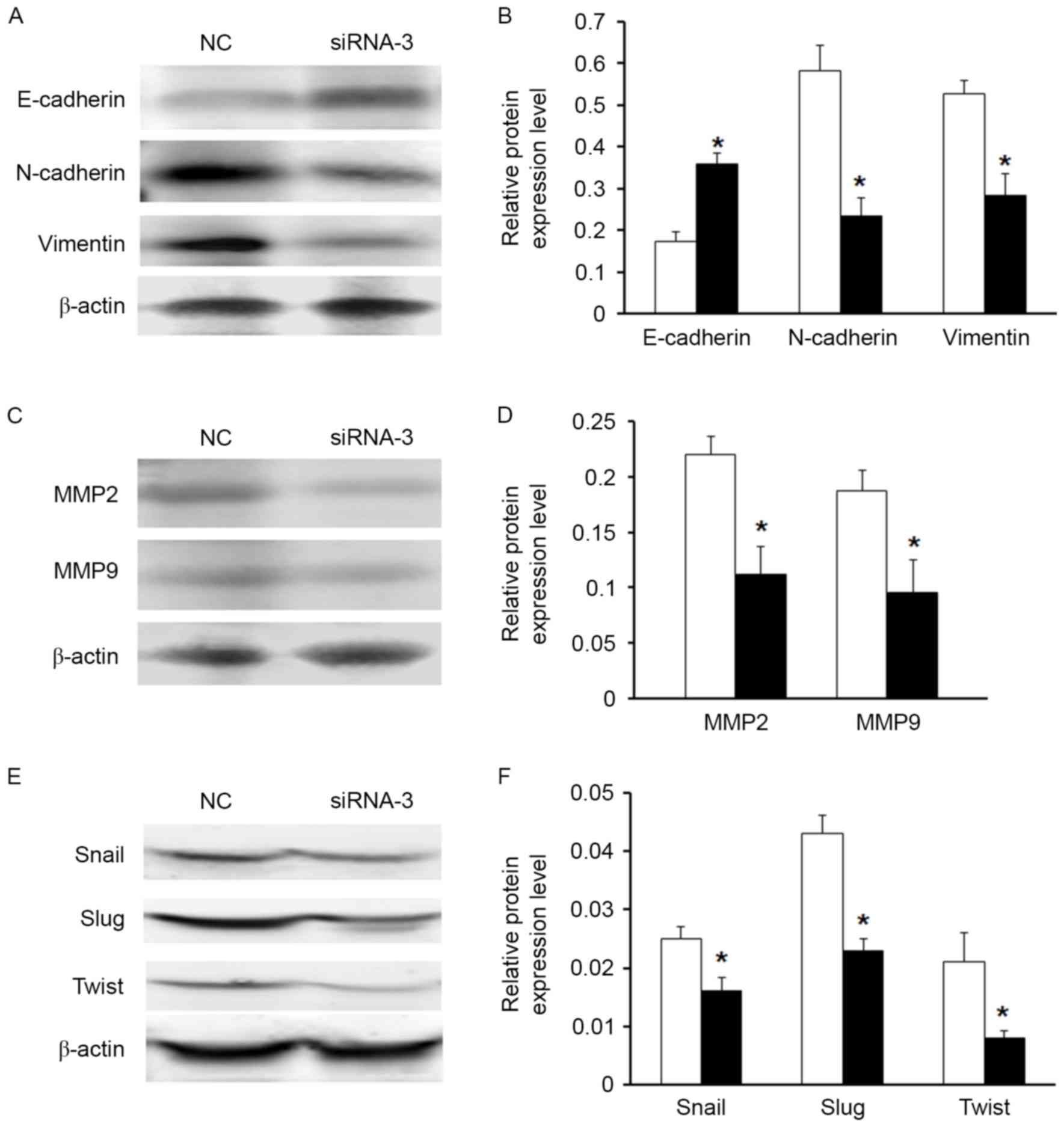Upregulation of HOXB7 promotes proliferation and metastasis of osteosarcoma cells
- Authors:
- Published online on: June 30, 2017 https://doi.org/10.3892/mmr.2017.6906
- Pages: 2773-2778
Abstract
Introduction
Osteosarcoma, the most common primary bone cancer, occurs mainly in adolescents and young adults, which is characterized by high malignant and metastatic potentials. It primarily occurs in actively growing long bone metaphysis (1). Despite an intensive search for new therapeutic strategies, survival rates have not improved over the past two decades (2). Because the metastatic process comprises a series of steps all of which require the participation of specific molecules. Therefore, it is crucial to identify novel molecules and novel alternative therapeutic strategies to improve the clinical outcome of patients with osteosarcoma.
Homeobox genes (HOX) encode a large family of transcriptional factors, which are essential for embryonic development and tumorigenesis (3,4). In addition, they are frequently deregulated in cancer where they variably influence tumor cell proliferation, apoptosis, stem cell renewal, differentiation, motility and angiogenesis (5–7). The authors previously reported that HOXB7 overexpression confers tamoxifen-resistance through upregulation of EGFR signaling in breast cancer (8). Increased expression of HOXB7 has also been described in oral squamous cell carcinoma, where it induces cell proliferation and has been indicated to be associated with poor prognosis (9). Moreover, in colorectal cancer, the protein encoded by HOXB7 was considered as a prognostic factor and mediator of tumor development and progression (10). Besides, the present study demonstrates that decreasing the HOXB7 expression level by small interfering (si)RNA could significantly increases cell cycle arrest and apoptosis in pancreatic ductal adenocarcinomas (11). In addition, previous studies have demonstrated that overexpression of HOXB7 is closely associated with the clinical progression and poor prognosis of patients with lung adenocarcinoma, esophageal squamous cell cancer (12,13) and gastric cancer (14). However, the role of HOXB7 in osteosarcoma has not been reported.
In the current study, the authors demonstrated that the expression of HOXB7 was increased in osteosarcoma tissues and cell lines compared with paired adjacent non-tumor bone tissues and osteoblastic cells. Following this, knockdown of HOXB7 expression was presented to inhibit cell viability, proliferation and migration, and suppress epithelial-mesenchymal transition (EMT), in an attempt to elucidate the potential influence of HOXB7 in the development of osteosarcoma.
Materials and methods
Tissue samples and cell lines
The 32 paired osteosarcoma specimens and adjacent non-tumor tissues used in the present study were obtained from surgically excised samples from Affiliated Hospital of Nantong University (Nantong, China). All research involving human tissue samples was approved by the Ethics Review Committee of Affiliated Hospital of Nantong University (Nantong, China) and written informed consent was obtained from all participating patients.
Saos-2, MG-63, HOS and U2OS osteosarcoma cell lines, and immortalized human fetal osteoblastic cell line hFOB 1.19, were obtained from the American Type Culture Collection (Manassas, VA, USA). Cells were cultured RPMI-1640 medium supplemented with 10% fetal bovine serum (Gibco; Thermo Fisher Scientific Inc., Waltham, MA, USA) and maintained at 37°C under 5% CO2.
Transfection of siRNA
For siRNA silencing of HOXB7, RNA interference was performed by using synthetic siRNA duplexes. HOXB7 siRNA and scrambled siRNA (NC-siRNA) were purchased from Shanghai GenePharma Co., Ltd. (Shanghai, China). The targeting sequences were as follows: siRNA1, 5′-GGAGCCTTCCCAGAACAAA-3′; siRNA2, 5′-CCCTTTGAGCAGAACCTCT-3′; siRNA3, 5′-GCCTCACGGAAAGACAGAT-3′. In the present study, siRNA3 was used as it can effectively reduce endogenous HOXB7 expression. The target sequence for scrambled siRNA was 5′-GCAGATAGGTAGGCGTTAT-3′. Si-HOXB7 or scramble siRNA were transfected into MG63 cells at 400 pmol respectively using Lipofectamine RNAiMAX transfection reagent (Invitrogen; Thermo Fisher Scientific, Inc.) according to the manufacturer's protocols. Following 24 h of transfection, cells were harvested for cell proliferation, migration and colony formation assays.
Reverse transcription-quantitative polymerase chain reaction (RT-qPCR)
Total RNA was extracted from tissues lysate using a TRIzol kit (Invitrogen; Thermo Fisher Scientific, Inc.), and cDNA was subsequently synthesized from total RNA using an Omniscript RT kit (Qiagen, Inc., Valencia, CA) following the supplier's protocols. RT-qPCR was conducted on the Mastercycler Ep Realplex (Eppendorf, Hamburg, Germany). The reactions used the following cycling conditions: Incubation at 96°C for 2 min, 40 cycles at 96°C for 15 sec and 60°C for 1 min. The Cq value was defined as the cycle number at which the fluorescence intensity reached a certain threshold where amplification of each target gene was within the linear region of the reaction amplification curves. GAPDH gene served as an internal control. Relative expression level for each target gene was normalized by the Ct value of GAPDH using a 2−ΔΔCq relative quantification method (15). The sequences of the primers for HOXB7 as follows: HOXB7 forward, 5′-ACACGCTCTGCCTCACG-3′; HOXB7 reverse, 5′-GCTTCAGCCCTGTCTTGG-3′.
Western blot analysis
Equal amounts of protein (20 µg) were separated by 10% SDS-PAGE and transferred onto polyvinylidene difluoride membranes. The membranes were blocked with 5% non-fat milk in TBS. Following blocking, the target proteins were probed with the following: Anti-HOXB7 antibody (cat. no. ab196007; 1:500; Abcam, Cambridge, MA, USA), anti-E-cadherin antibody (cat. no. ab1416; 1:1,000; Abcam), anti-vimentin antibody (cat. no. ab92547; 1:1,000; Abcam), anti-N-cadherin antibody (cat. no. ab18203; 1:1,000, Abcam), anti-Snail antibody (cat. no. ab180714; 1:1,000; Abcam), anti-Slug antibody (cat. no. ab27568; 1:1,000; Abcam) and anti-Twist antibody (cat. no. ab49254; 1:1,000; Abcam) overnight at 4°C. Then, the blots were washed and incubated with a horseradish peroxidase-conjugated secondary antibody (cat. no. ab6789 or cat. no. ab6721; 1:5,000; Abcam). The membrane was incubated for 1 h at room temperature and washed with PBS three times, each time for 10 min. An enhanced chemiluminescence kit (cat. no. 32106; Thermo Fisher Scientific, Inc.) was used to visualize the membrane. The densities of protein bands were analyzed using PDQuest software version 7.2.0 (Bio-Rad Laboratories, Inc., Hercules, CA, USA). The expression of proteins was normalized to β-actin.
Cell viability assay
Cell viability was analyzed using an MTT assay. Cells transfected with HOXB7 siRNA, scrambled siRNA (NC) or no transfection (untreated) were seeded into 96-well plates (5×103 cells/well) and incubated for 1, 2, 3, 4 and 5 days, respectively. Following incubation with 25 µl MTT (5 mg/ml) (Sigma-Aldrich; Merck KGaA, Darmstadt, Germany) at 37°C for 4 h, the supernatants were removed, and 150 µl dimethyl sulfoxide (Sigma-Aldrich; Merck KGaA) was added to each well. The absorbance value of each well was measured at 490 nm. Experiments were repeated at least three times.
Colony formation assay
Cells (5×104 cells/well) were separately plated in a 24-well plate. At 24 h, the cells were collected and seeded (1,000–1,500/well) in a fresh six-well plate for 14 days. Surviving colonies (>50 cells per colony) were counted following fixing with methanol/acetone and stained with 5% Gentian Violet (ICM Pharma, Singapore), and then rinsed three times with PBS to remove excess dye, photographed and counted. The experiment was carried out in triplicate.
Transwell assay
The migration ability of cells was measured in Transwell chambers with 8.0 mm pore polycarbonate membrane insert (Corning Incorporated, Corning, NY, USA) according to the manufacturer's protocols. Cells (5×104/ml) suspended in Dulbecco's' modified Eagle's medium (DMEM) were added to the upper chamber, and the plate was incubated with 5% CO2 for 12 h at 37°C. The lower chamber of the plate was filled with 500 µl DMEM containing 10% fetal bovine serum (Invitrogen; Thermo Fisher Scientific, Inc.). Cells on the upper surface of the filters were removed using cotton swabs. The migrated cells to the lower surface of the filters were washed, fixed, stained with Giemsa and counted under a microscope. Experiments were repeated at least three times.
Statistical analysis
All data were analyzed using SPSS software version 17.0 (SPSS, Inc., Chicago, IL, USA) and presented as the mean ± standard error of the mean. Statistical analysis was determined using Student's t-test. P<0.05 was considered to indicate a statistically significant difference.
Results
Expression of HOXB7 was upregulated in osteosarcoma
Western blotting indicated that the expression of HOXB7 in osteosarcoma tissues was significantly upregulated compared with corresponding adjacent non-tumor tissues. A total of 6 representative pairs of the western blotting results are presented in Fig. 1A. In addition, the protein level of HOXB7 was higher in osteosarcoma tissues than in their adjacent non-tumor tissues in the 24 randomly selected pairs (Fig. 1B; P=0.006). Moreover, to measure HOXB7 mRNA level in osteosarcoma tissues, RT-qPCR was performed in the 32 tumor tissues and corresponding non-tumor samples. The results demonstrated that HOXB7 expression was significantly increased in tumor samples when compared with that in their matched non-tumor tissues (Fig. 1C; P=0.008).
Furthermore, the expression of HOXB7 was investigated in four osteosarcoma cell lines (MG63, U2OS, Saos-2 and HOS). RT-qPCR and western blot analysis indicated that the HOXB7 level was higher in four osteosarcoma cell lines than in the hFOB 1.19 cell line (Fig. 2A and B).
Downregulation of HOXB7 inhibited cell viability, proliferation and migration
Western blotting indicated that HOXB7 siRNA-3 decreased the level of HOXB7 expression more effectively than control and other siRNAs (Fig. 3A and B). To obtain a further insight into the role of HOXB7 in the tumorigenesis of osteosarcoma, the effect of HOXB7 knockdown on cell viability, proliferation and migration was examined by MTT, Transwell and colony formation assays. The results of MTT assay indicated that downregulation of HOXB7 suppressed MG63 cells proliferation (Fig. 3C; P<0.05). Moreover, the Transwell assay demonstrated that knockdown of HOXB7 expression significantly inhibited the migratory capacity of MG63 cells compared with that of control cells (Fig. 4A and B; P<0.05). Furthermore, colony formation assay displayed that downregulation of HOXB7 significantly decreased the proliferation, leading to the more less numbers of colonies compared with the control (Fig. 4C and D; P<0.05).
Overexpression of HOXB7 induced EMT
EMT has previously been linked to tumor progression by which the epithelial cells acquire mesenchymal properties and show reduced intercellular adhesion and increased motility (16). As measured by western blotting, downregulation of HOXB7 expression induced the protein expression of E-cadherin and suppressed the protein expression of vimentin and N-cadherin in the MG63 cell line (Fig. 5A and B). Moreover, downregulation of HOXB7 expression significantly inhibited MMP2 and MMP7 protein levels in MG63 cells (Fig. 5C and D). It was further investigated whether other EMT markers were regulated following knockdown of HOXB7 expression by western blot analysis. The results demonstrated that cells with knockdown expression of HOXB7 expressed loss of mesenchymal markers (Snail, Slug and Twist), which is consistent with vimentin and N-cadherin expression (Fig. 5E and F).
Discussion
Transcriptional factors encoded by HOX genes regulate cell cycle, proliferation, apoptosis and cell mobility (7), and their abnormal expression is often associated with diseases, thus attracting increasing attention in cancer research (6,17). In particular, aberrant expression of HOXB7 has been presented in different tumor types, including breast cancer (18), ovarian cancer (19), oral cancer (20), colorectal cancer (10), lung cancer (12), melanoma (21) and pancreatic cancer (11). To the best of the authors' knowledge, the present study is the first to demonstrate the potential role of HOXB7 in osteosarcoma. HOXB7 was identified as being generally overexpressed in osteosarcoma tissues and cell lines. Therefore, theoretically, HOXB7 may serve an oncogenic role in osteosarcoma pathogenesis.
Furthermore, previous studies indicated that an enforced expression of HOXB7 in hematopoietic progenitors stimulates self-renewal, sustaining proliferation and differentiation (22). In the current study, the current results indicated that ectopic expression of HOXB7 promoted osteosarcoma cells viability, proliferation and migration. In addition, overexpression of HOXB7 induces EMT. So, the present results was corroborated by previous findings where HOXB7 is overexpressed in a number of cancers and encompasses many oncogenic functions, which has been demonstrated to promote cell migration and invasion, and induce EMT and angiogenesis (21). Taken together, previous efforts were used to elucidate that HOXB7 promotes tumor progression in a cell-autonomous and non-cell-autonomous manner through activation of the transforming growth factor-β signaling pathway (23). Modulation of the tumor proliferation effect through inhibiting PI3K/AKT or mitogen-associated protein kinase activation mediated by HOXB7 overexpression may be used as a potential target for cancer prevention and therapy (10). Finally, they collectively provide compelling circumstantial evidence that HOXB7 functions dominantly to facilitate tumor progression in many solid tumor types, including osteosarcoma.
In summary, the present study demonstrated that HOXB7 was increased in osteosarcoma tissues and cell lines. Overexpression of HOXB7 promoted the cell proliferation and migration. Moreover, knockdown of HOXB7 expression resulted in the increase of epithelial markers E-cadherin, and decrease of mesenchymal marker vimentin. To the best of our knowledge, the present study is the first to demonstrate that the HOXB7 regulates the proliferation and migration of osteosarcoma cells.
References
|
Damron TA, Ward WG and Stewart A: Osteosarcoma, chondrosarcoma, and Ewing's sarcoma: National cancer data base report. Clin Orthop Relat Res. 459:40–47. 2007. View Article : Google Scholar : PubMed/NCBI | |
|
Siegel HJ and Pressey JG: Current concepts on the surgical and medical management of osteosarcoma. Expert Rev Anticancer Ther. 8:1257–1269. 2008. View Article : Google Scholar : PubMed/NCBI | |
|
Corsetti MT, Levi G, Lancia F, Sanseverino L, Ferrini S, Boncinelli E and Corte G: Nucleolar localisation of three hox homeoproteins. J Cell Sci. 108:187–193. 1995.PubMed/NCBI | |
|
Inamori K, Takeshita K, Chiba S, Yazaki Y and Hirai H: Identification of homeobox genes expressed in human T-lymphocytes. Biochem Biophys Res Commun. 196:203–208. 1993. View Article : Google Scholar : PubMed/NCBI | |
|
Samuel S and Naora H: Homeobox gene expression in cancer: Insights from developmental regulation and deregulation. Eur J Cancer. 41:2428–2437. 2005. View Article : Google Scholar : PubMed/NCBI | |
|
Abate-Shen C: Deregulated homeobox gene expression in cancer: Cause or consequence? Nat Rev Cancer. 2:777–785. 2002. View Article : Google Scholar : PubMed/NCBI | |
|
Shah N and Sukumar S: The Hox genes and their roles in oncogenesis. Nat Rev Cancer. 10:361–371. 2010. View Article : Google Scholar : PubMed/NCBI | |
|
Jin K, Kong X, Shah T, Penet MF, Wildes F, Sgroi DC, Ma XJ, Huang Y, Kallioniemi A, Landberg G, et al: The HOXB7 protein renders breast cancer cells resistant to tamoxifen through activation of the EGFR pathway. Proc Natl Acad Sci USA. 109:2736–2741. 2012. View Article : Google Scholar : PubMed/NCBI | |
|
Bitu CC, Carrera M, Lopes MA, Kowalski LP, Soares FA and Coletta RD: HOXB7 expression is a prognostic factor for oral squamous cell carcinoma. Histopathology. 60:662–665. 2012. View Article : Google Scholar : PubMed/NCBI | |
|
Liao WT, Jiang D, Yuan J, Cui YM, Shi XW, Chen CM, Bian XW, Deng YJ and Ding YQ: HOXB7 as a prognostic factor and mediator of colorectal cancer progression. Clin Cancer Res. 17:3569–3578. 2011. View Article : Google Scholar : PubMed/NCBI | |
|
Chile T, Fortes MA, Corrêa-Giannella ML, Brentani HP, Maria DA, Puga RD, de Paula Vde J, Kubrusly MS, Novak EM, Bacchella T and Giorgi RR: HOXB7 mRNA is overexpressed in pancreatic ductal adenocarcinomas and its knockdown induces cell cycle arrest and apoptosis. Bmc Cancer. 13:4512013. View Article : Google Scholar : PubMed/NCBI | |
|
Yuan W, Zhang X, Xu Y, Li S, Hu Y and Wu S: Role of HOXB7 in regulation of progression and metastasis of human lung adenocarcinoma. Mol Carcinog. 53:49–57. 2014. View Article : Google Scholar : PubMed/NCBI | |
|
Xie X, Zhang SS, Wen J, Yang H, Luo KJ, Yang F, Hu Y and Fu JH: Prognostic value of HOXB7 mRNA expression in human oesophageal squamous cell cancer. Biomarkers. 18:297–303. 2013. View Article : Google Scholar : PubMed/NCBI | |
|
Tu W, Zhu X, Han Y, Wen Y, Qiu G and Zhou C: Overexpression of HOXB7 is associated with a poor prognosis in patients with gastric cancer. Oncol Lett. 10:2967–2973. 2015.PubMed/NCBI | |
|
Livak KJ and Schmittgen TD: Analysis of relative gene expression data using real-time quantitative PCR and the 2(−Delta Delta C(T)) Method. Methods. 25:402–408. 2001. View Article : Google Scholar : PubMed/NCBI | |
|
Mani SA, Guo W, Liao MJ, Eaton EN, Ayyanan A, Zhou AY, Brooks M, Reinhard F, Zhang CC, Shipitsin M, et al: The epithelial-mesenchymal transition generates cells with properties of stem cells. Cell. 133:704–715. 2008. View Article : Google Scholar : PubMed/NCBI | |
|
Grier DG, Thompson A, Kwasniewska A, Mcgonigle GJ, Halliday HL and Lappin TR: The pathophysiology of HOX genes and their role in cancer. J Pathol. 205:154–171. 2005. View Article : Google Scholar : PubMed/NCBI | |
|
Wu X, Chen H, Parker B, Rubin E, Zhu T, Lee JS, Argani P and Sukumar S: HOXB7, a homeodomain protein, is overexpressed in breast cancer and confers epithelial-mesenchymal transition. Cancer Res. 66:9527–9534. 2006. View Article : Google Scholar : PubMed/NCBI | |
|
Naora H, Yang YQ, Montz FJ, Seidman JD, Kurman RJ and Roden RB: A serologically identified tumor antigen encoded by a homeobox gene promotes growth of ovarian epithelial cells. Proc Natl Acad Sci USA. 98:4060–4065. 2001. View Article : Google Scholar : PubMed/NCBI | |
|
De Souza Setubal Destro MF, Bitu CC, Zecchin KG, Graner E, Lopes MA, Kowalski LP and Coletta RD: Overexpression of HOXB7 homeobox gene in oral cancer induces cellular proliferation and is associated with poor prognosis. Int J Oncol. 36:141–149. 2010.PubMed/NCBI | |
|
Caré A, Silvani A, Meccia E, Mattia G, Stoppacciaro A, Parmiani G, Peschle C and Colombo MP: HOXB7 constitutively activates basic fibroblast growth factor in melanomas. Mol Cell Biol. 16:4842–4851. 1996. View Article : Google Scholar : PubMed/NCBI | |
|
Carè A, Valtieri M, Mattia G, Meccia E, Masella B, Luchetti L, Felicetti F, Colombo MP and Peschle C: Enforced expression of HOXB7 promotes hematopoietic stem cell proliferation and myeloid-restricted progenitor differentiation. Oncogene. 18:1993–2001. 1999. View Article : Google Scholar : PubMed/NCBI | |
|
Liu S, Jin K, Hui Y, Fu J, Jie C, Feng S, Reisman D, Wang Q, Fan D, Sukumar S and Chen H: HOXB7 promotes malignant progression by activating the TGFβ signaling pathway. Cancer Res. 75:709–719. 2015. View Article : Google Scholar : PubMed/NCBI |














